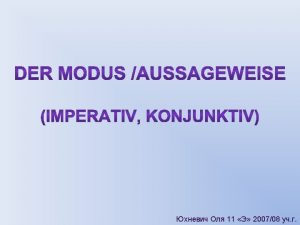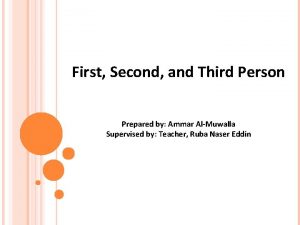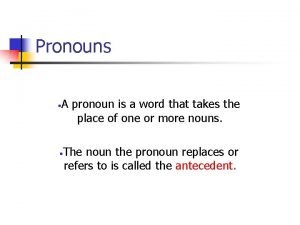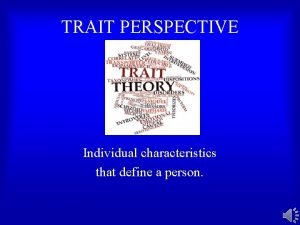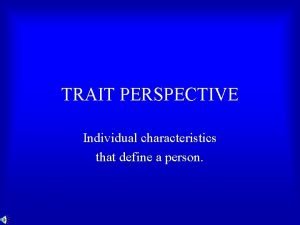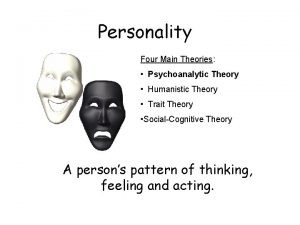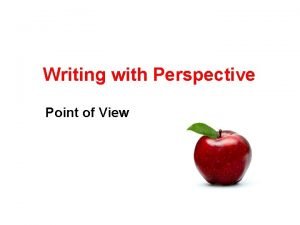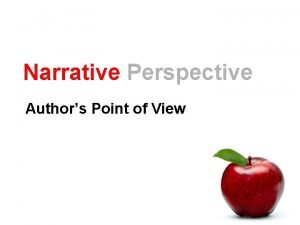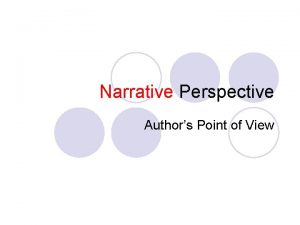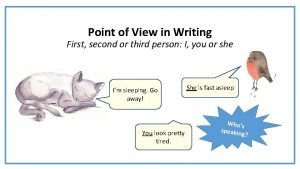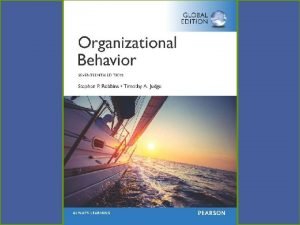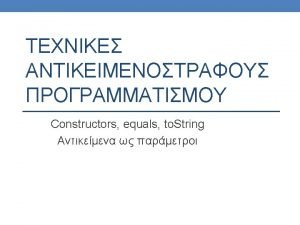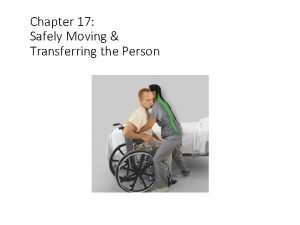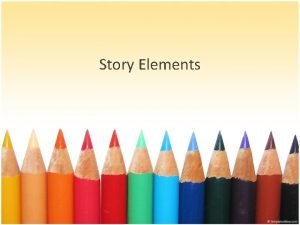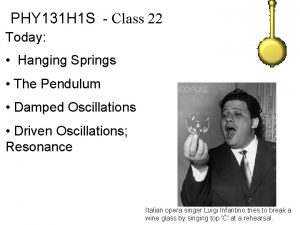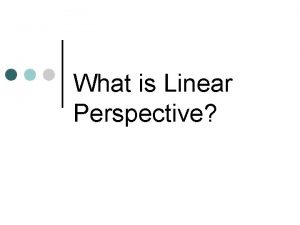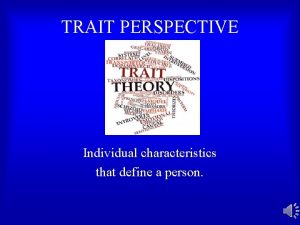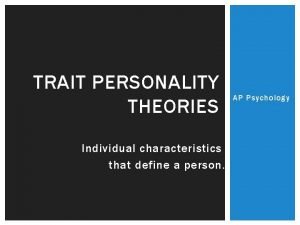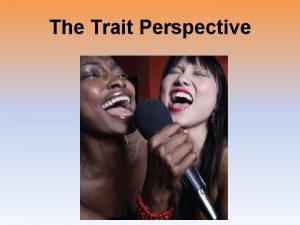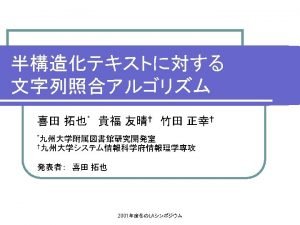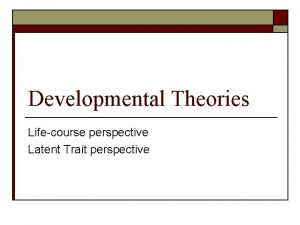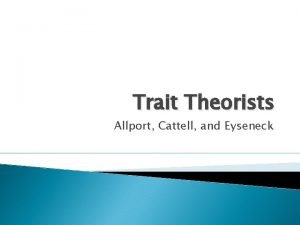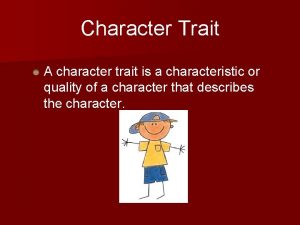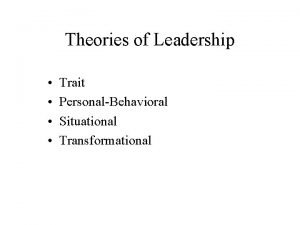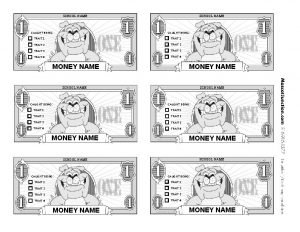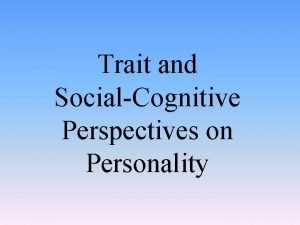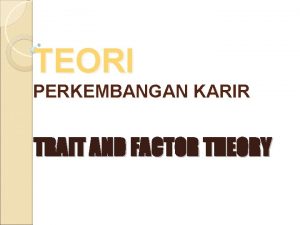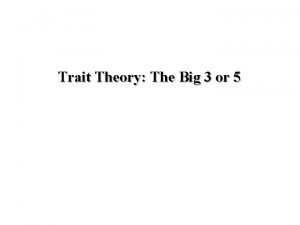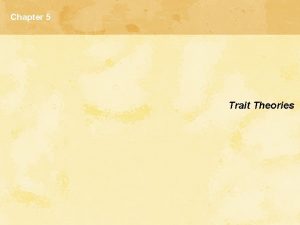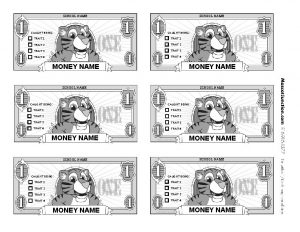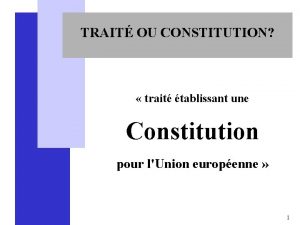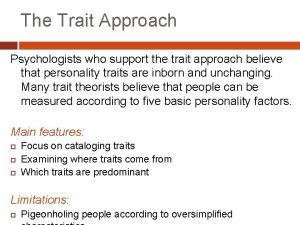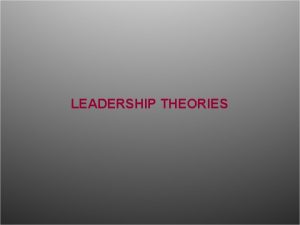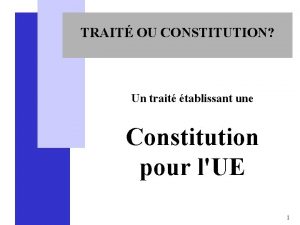TRAIT PERSPECTIVE Individual characteristics that define a person





































- Slides: 37

TRAIT PERSPECTIVE Individual characteristics that define a person.

Trait • Tendency toward certain behaviors or emotions, no matter the situation • Believe that these personality traits are stable & predictable over time. • Trait Perspective focus on individual differences rather than similarities like previous theories. • Trait Theories seek to identify, describe and measure these individual differences. • Don’t try to form judgements or values about one’s traits

Ancient Greek Traits • Ancient Greeks classified four personality traits: – Blood - Sanguine (cheerful, talkative, careless) – Black Bile - Melancholic (depressed, moody, introverted) – Yellow Bile - Phlegmatic (relaxed, reliable, peaceful) – Green Bile – Choleric (independent, ambitious) • Felt these were caused by an excess in humor (body fluids)


Personality Types • Type A: Driven, competitive, rigid, hostile & intense – Type A personalities that are hostile, angry and negative more prone to stress-related illness like heart disease. • Type B: Calm, laid back & easy going • Critics argue can’t place all people into just two categories.

Gordon Allport (1897 -1967) • First to try to list & describe fundamental human traits • Studied the English dictionary and found more than 18, 000 words describing specific personality traits. Eliminated synonyms to get the list to 171 • Assumed traits are inherited and fixed in the nervous system.

Raymond Cattell (1905 -1998) • Used factor analysis - Organized questions into categories – Then looks for common answers to these – Used to reduce the list of personality traits. • Came up with 16 key personality dimensions (source traits) or factors to describe personality • Proposed Each factor was measured on a continuum • Generally considered as too many traits

Cattell’s 16 Personality Factors Example Questions and Profiles The 16 PF, developed by Raymond Cattell, is a self-report inventory that contains 185 items like those shown in part (a). When scored, the 16 PF generates a personality profile. In part (b), personality profiles of airline pilots and writers are compared. Cattell (1973) found that pilots are more controlled, more relaxed, more self -assured, and less sensitive than writers

Hans & Sybil Eysenck • • • German psychologist who researched the genetically-influenced dimensions of personality Believed we have 2 personality dimensions: 1. Extroversion: Introversion-extraversion – Degree to which a person directs their energies inward toward themselves (introvert) or outward onto others (extrovert). 2. Neuroticism: Emotional stability- Instability (Stable – Unstable) – A person’s predisposition to become unpredictable & emotionally upset (unstable) or stay composed, rational and emotionally even (stable). Generally considered as too few traits

Eysencks’ Personality Factors

Eysencks’ Personality Factors

Eysencks’ Personality Factors

Eysencks’ Personality Factors

Eysencks’ Personality Factors

Eysencks’ Personality Factors

Eysenck is similar to Hippocrates Melancholic Phlegmatic Choleric Sanguine

William Sheldon & body types (1898 -1977) Your body type determines your personality

Sheldon’s endomorph • Love of food • Love of comfort • Sociable • Good-humored • Relaxed • Tolerant

Sheldon’s ectomorph • Self-conscious • Private • Introverted • Intense • Artistic • Restrained

Sheldon’s mesomorph • Adventurous • Dominant • Courageous • Indifferent • Competitive • Risk-taker

Is Sheldon’s Theory Accurate? • No, It is based on Stereotypes. • Is this a self-fulfilling prophecy?

The Notorious BIG 5 Theory • Most popular trait theory • Essential building blocks of personality can be described in 5 basic personality dimensions. • Described somewhat differently among researchers but can be found cross culturally. • Research shows them to be stable over time & consistent over different situations. • Human behavior is the result of interaction between traits and situations. • Can be used to predict a person’s behavior

O. C. E. A. N. • OPENNESS – How open you are to new experiences & learning? • CONSCIENTIOUSNESS – The degree to which one is responsible, hard working, reliable (dependability) • EXTROVERSION – How outgoing, expressive, active & social are you? • AGREEABLENESS – How honest, considerate, likeable & tolerant are you? • NEUROTICISM – How anxious, self-conscious or impulsive are you?


Brain & Personality • Extraverts: seek out stimulation because their brain arousal is low. – PET Scans show that Front Lobe are involved in inhibiting behavior is less active • Autonomic Nervous System Reactivity – if born with an active ANS then may grow up to be anxious and cautious – Opposite true if born with a less active ANS

Nature vs. Nurture • Behavioral genetics compare identical twins raised apart and together or compare identical twins & fraternal twins. Findings: • Extraversion & Neuroticism seem genetically linked. Identicals are more alike in these areas even when raised apart. Also true to lesser extent in Openness to Experience & Conscientiousness • Environmental factors influence personality traits – identical twins more alike earlier in life rather than later.

Psychological Testing • Psychological tests assess a person’s abilities, aptitudes, interests or personality based on a systematically obtained sample of behavior. 2 Basic Goals 1. Accurately & consistently reflect a person’s characteristics on some dimension. 2. Predicts a person’s future psychological functioning or behavior.

Personality Inventories • Questionnaires on which people respond to items designed to gauge a wide range of feelings and behaviors • Used to assess selected personality traits • Often true-false, agree-disagree, etc. types of questions • Person’s responses to standardized questions are compared to established norms.

Validity • The extent to which a test measures or predicts what it is suppose to test • Personality inventories offer greater validity than do projective tests (e. g. Rorschach).

Reliability • The extent to which a test yields consistent results, regardless of who gives the test or when or where it is given • Personality inventories are more reliable than projective tests.

MMPI • Minnesota Multiphasic Personality Inventory (MMPI) • Most clinically-used personality test • 500 total T/F questions • Empirically derived – studied data from large groups then compared them. • Originally designed to assess abnormal behavior

MMPI Scoring Profile

Myers-Briggs Type Indicator • 126 Questions used to sort people according to Carl Jung’s personality types (see next slide) • Each personality type expressed according to its strengths (make you look good) • Originally used as a predictor of job performance at certain tasks – Not supported by research • Used as a counseling or coaching tool NOT a research device • Contains lie detecting statements – “I dislike no one. ” - TRUE (Liar!)

Personality Traits of MBTI What Personality are you? Try taking the test yourself HERE



Evaluation of Trait Perspective • Person-Situation Controversy - Personality is influenced by both our inner disposition and environment interacting • Although personality traits are stable, our behaviors across different situations are not. • Personality Tests are weak predictors of behavior because behavior changes so much across situations – Although average outgoingness, happiness & carelessness across many situations is predictable. • Psychologists generally accept that people can be described & compared in terms of basic personality traits. • Doesn’t really explain where personality comes from, simply describe the behaviors • Fails to address how issues such as motives, unconscious, or beliefs about self affect personality development
 Plural 1 person
Plural 1 person 3rd person perspective
3rd person perspective Person person = new person()
Person person = new person() First second and third person
First second and third person Phân độ lown ngoại tâm thu
Phân độ lown ngoại tâm thu Block nhĩ thất độ 2 mobitz 1
Block nhĩ thất độ 2 mobitz 1 Thể thơ truyền thống
Thể thơ truyền thống Thơ thất ngôn tứ tuyệt đường luật
Thơ thất ngôn tứ tuyệt đường luật Walmart thất bại ở nhật
Walmart thất bại ở nhật Tìm vết của đường thẳng
Tìm vết của đường thẳng Con hãy đưa tay khi thấy người vấp ngã
Con hãy đưa tay khi thấy người vấp ngã Tôn thất thuyết là ai
Tôn thất thuyết là ai Gây tê cơ vuông thắt lưng
Gây tê cơ vuông thắt lưng Sau thất bại ở hồ điển triệt
Sau thất bại ở hồ điển triệt Define individual characteristics
Define individual characteristics Trait perspective psychology
Trait perspective psychology Humanistic theory of personality
Humanistic theory of personality Homozygous dominant
Homozygous dominant 1 point vs 2 point perspective
1 point vs 2 point perspective Silo perspective vs business process perspective
Silo perspective vs business process perspective Clue words for third person point of view
Clue words for third person point of view Second person perspective
Second person perspective What is first person point of view
What is first person point of view Define individual health
Define individual health Is we third person writing
Is we third person writing First person vs third person writing
First person vs third person writing Person-job fit and person-organization fit
Person-job fit and person-organization fit Types of conflict in fahrenheit 451
Types of conflict in fahrenheit 451 Private.com
Private.com When a person is logrolled the person is
When a person is logrolled the person is An account of a person's life written by that person
An account of a person's life written by that person A person's trash is another person's treasure
A person's trash is another person's treasure Chapter 19 safely transferring the person
Chapter 19 safely transferring the person Third person point of view example
Third person point of view example Person a and person b
Person a and person b A person swings on a swing when the person sits still
A person swings on a swing when the person sits still Hello how are you what are you doing now
Hello how are you what are you doing now What is linear perspective
What is linear perspective
